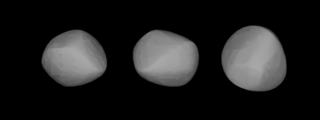
36 Atalante is a large, dark main-belt asteroid. It was discovered by the German-French astronomer H. Goldschmidt on October 5, 1855, and named by French mathematician Urbain Le Verrier after the Greek mythological heroine Atalanta. It was rendered 'Atalanta' in English sources in the 19th century. This asteroid is classified as C-type (carbonaceous), according to the Tholen classification system.

115 Thyra is a fairly large and bright inner main-belt asteroid that was discovered by Canadian-American astronomer J. C. Watson on August 6, 1871 and was named for Thyra, the consort of King Gorm the Old of Denmark. Based upon its spectrum, it is categorized as a stony S-type asteroid.

394 Arduina is an asteroid from the central regions of the asteroid belt. It was discovered by A. Borrelly on 19 November 1894 in Marseilles.
410 Chloris is a very large main-belt asteroid that was discovered by Auguste Charlois on January 7, 1896, in Nice. It is classified as a C-type asteroid and is probably composed of primitive carbonaceous material. The spectrum of the asteroid displays evidence of aqueous alteration. It is the namesake of the Chloris family of asteroids.
411 Xanthe is an asteroid from the outer regions of the asteroid belt, approximately 77 kilometers in diameter. It was discovered by French astronomer Auguste Charlois at Nice Observatory on 7 January 1896. The asteroid was named after Xanthe, an Oceanid or sea nymph, and one of the many Titan daughters of Oceanus and Tethys from Greek mythology.
414 Liriope is a large Main belt asteroid. It is classified as a C-type asteroid and is probably composed of carbonaceous material.
415 Palatia is a large main belt asteroid that was discovered by German astronomer Max Wolf on 7 February 1896 in Heidelberg.

417 Suevia is a typical Main belt asteroid. It is classified as a K-type/S-type asteroid.
419 Aurelia is a main-belt asteroid that was discovered by German astronomer Max Wolf on September 7, 1896, in Heidelberg. It is classified as an F-type asteroid.
420 Bertholda is a very large main-belt asteroid. It was discovered by Max Wolf on September 7, 1896, in Heidelberg, Germany. The object is part of the Cybele asteroid group, and is classified as a P-type asteroid.
421 Zähringia, provisional designation 1896 CZ, is a stony asteroid from the intermediate asteroid belt, approximately 14 kilometers in diameter. It was discovered on 7 September 1896, by astronomer Max Wolf at Heidelberg Observatory in Germany. The asteroid was named for the House of Zähringen, a medieval noble family that ruled parts of Swabia and Switzerland.
422 Berolina is a typical Main belt asteroid.
424 Gratia is a large Main belt asteroid.

425 Cornelia is a large Main belt asteroid. It was discovered by Auguste Charlois on 28 December 1896 in Nice. It is named after Cornelia Africana.
443 Photographica is a typical Main belt asteroid. It is classified as an S-type asteroid.
446 Aeternitas is a main belt asteroid. It was discovered by Max Wolf and A. Schwassmann on 27 October 1899 in Heidelberg. It is classified as an A-type asteroid. The asteroid is roughly 45 km in diameter and has a high albedo.

626 Notburga is a large, dark asteroid orbiting the Sun in the asteroid belt.
633 Zelima is a minor planet orbiting the Sun in the asteroid belt with a magnitude of 10.7. The name may have been inspired by the asteroid's provisional designation 1907 ZM.
871 Amneris is a minor planet orbiting the Sun. It is the namesake of the Amneris family, a subgroup of the Flora family of Main Belt asteroids.
2021 LL37 is a large trans-Neptunian object in the scattered disc, around 600 kilometres (370 miles) in diameter. It was discovered on 12 June 2021, by American astronomers Scott Sheppard and Chad Trujillo using Cerro Tololo Inter-American Observatory's Dark Energy Camera in Chile, and announced on 31 May 2022. It was 73.9 astronomical units from the Sun when it was discovered, making it one of the most distant known Solar System objects from the Sun as of May 2022. It has been identified in precovery images from as far back as 28 April 2014.






